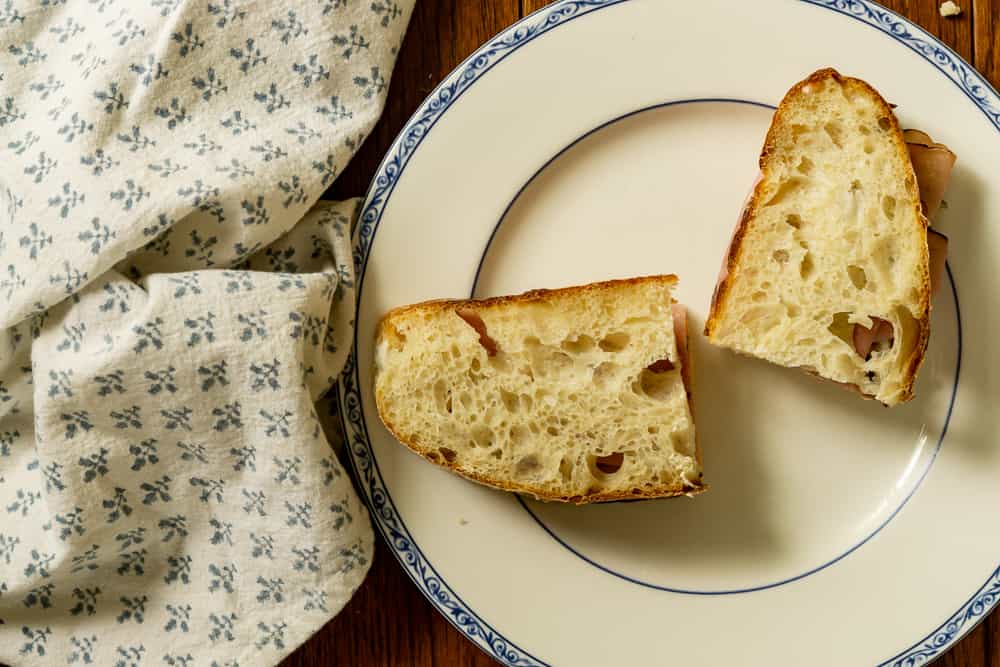Sourdough FAQs and Troubleshooting
Inside: A look at common sourdough problems and some possible solutions to troubleshoot your sourdough bread.
Of all the things in the kitchen that are finicky and unpredictable, sourdough might be number one. You can follow the exact same technique and even weigh things precisely and come out with different results. It’s just how it is.

Part of it is the state of your starter. It may be the temperature of your kitchen. And sometimes it is just the bread gods. But there are also things that you can control to affect the success of your sourdough baking. Here are some of the most frequent problems that occur with sourdough bread and some possible answers.
Sourdough Sundays Newsletter

Every Sunday evening I’ll send you a sourdough recipe to make that week, straight from my kitchen to your inbox.
And as a thank you for signing up, I’ll send you this e-book with beautiful printable recipes right away. Simple!
You will not be added to any other email lists or my daily newsletter. But if you’re already on my newsletter, you’re welcome to join and receive both.
Why didn’t my sourdough bread rise?
A common question with a lot of answers.
There are two big possibilities: either your starter is not healthy, or conditions were not right.
Your starter should look very vigorous and should have been fed a few hours before baking with it. There should be obvious bubbles and a lot of activity when you peek in. If your starter is young (less than one month old), it is probably not ready to bake a full loaf with by itself. Add a pinch of commercial yeast to your dough until the starter matures a bit. It’s nothing be ashamed of!
If you are confident that your starter is mature and healthy, then something went wrong during the bread-making process itself.
Think about the temperatures your dough has been exposed to. Did you accidentally add hot water and kill the starter? Did you try to proof in a cold room (this will actually work fine, but it will take at least 5 hours)? Did you proof in a warm oven that was too hot? Any of these can kill the starter or fail to encourage growth.
Another thing that will cause your loaf to be flat is an underdeveloped structure. If you have a high hydration (wetter) loaf, it needs to be built up over time so that it is strong enough to stand on its own a bit. Otherwise, it will act like a pancake batter, spread out, and be flat. Did you knead your dough and/ or do the “folding process” adequately (more information on the folding process in this video).
Overproofing can result in a flat loaf as well. Sourdough rising times are flexible, but there are still limits. After 12 hours, even in the refrigerator, you are pushing the limits of how long your wild yeast can keep working.
I’m not saying that it won’t work, and many people report success with a 16-hour refrigerated final proof, but you are up against the limits. Try reducing your rise times are see what happens.
If you feel that your starter is strong, you kneaded properly, and your loaf is still flat… try using steam. Sourdough’s final rise heavily depends on oven spring, or its ability to quickly puff up when it hits the heat of the oven. The best way to aid this is with steam. You can achieve this with a lidded Dutch oven or with an empty-rimmed baking sheet preheated in your oven. Simply pour in one cup of water the same time you put your bread in, and the steam will help.
Why is my sourdough bread so dense?
This is often related to issues with rising, but not always.
If your bread seems dense but it rose well and had good oven spring and doesn’t seem too flat, then there is something else going on.
The main issue with density is flour. The lightest, airiest bread will be made with white bread flour. If you want whole wheat, rye, spelt, or any other crazy flours, you have to accept that you are going to have a denser finished product.
Try adding other flours at ten percent of the total amount of flour and increasing it until your bread is too dense for your liking.
How can I make sourdough bread more sour?
You can do a longer, cooler fermentation period (just watch out for overproofing).
You can feed your starter less often, which makes the starter itself more sour and sours the bread more.
You can mix whole wheat or rye flour into your starter, which also makes the sourer bacteria thrive.
You may notice that all of these things work against having a light and airy loaf. This is true.
If you want a light, open-crumb sourdough that is also very sour, the best thing to do is to simply add citric acid at the beginning of the bread-making process. Normally less than 1/2 teaspoon will have an effect on the flavor.
Why is my starter not healthy and bubbly?
Sometimes this is a simple issue of your starter not being old enough. It takes weeks of regular feedings for your starter to be healthy. If your starter seems sluggish and you are keeping it in the fridge, try storing it on your counter so you can keep an eye on it and use it more.
Don’t be too quick to give up on a starter. They can recover from a lot of neglect, although it will take time to get back to a state that is suitable for baking. When you are trying to revive a neglected starter, the best thing to do to get it back up to speed is to feed it twice (or even three times!) a day, keep it on the counter, and dump out half of it twice a day. This keeps the correct balance of the right bugs in there. Once it seems healthy again, go back to a more minimal maintenance schedule.
Why is my sourdough bread gummy inside?
This is a common problem, and the most frequent reason is that it needs more time to cool. I try to wait at least 2 hours after baking before slicing into the bread. Many people recommend waiting 4 hours, or even overnight.
The good news is, even if you cut into it too soon and it seems gummy, the texture will still improve as it cools. You may have squished down some of the air holes by cutting too early, but the gumminess will go away
If you are still having trouble, try backing up a little and do a recipe that uses a little commercial yeast, too, until you are more comfortable.
Recipes to Build Your Sourdough Confidence.
I’ve found that these are the main issues that people have with their sourdough bread.
All these recipes use a small amount of commercial use and act like a normal bread dough. As your confidence grows and your starter gets healthier, you can leave out the yeast.
For More Help
If you have any questions or problems, just ask and I will try to help you.
Love,












When I make sourdough bread I typically to 3 stretch and folds. I find that my dough gets looser & stickier with each stretch and fold. I doesn’t get tighter, smoother, and more elastic. Any tips?
Tonia what recipe are you using? I’d personally try lowering the hydration a bit.
Excellent instructions. Thank you so much.
you are so very welcome 🙂
hey! i made my first starter and loaf and think its too wet! its very gummy. do you have a link for a starter or a way to fix mine.
hi carter! your starter will be very wet, like a pancake batter. as far as your loaf, that’s sort of personal preference. some like a high hydration but it’s harder to work with. I’ll link my starter recipe and you can compare how yours looks, and i’ll link my favorite beginner loaf. https://heartscontentfarmhouse.com/sourdough-starter-recipe/ https://heartscontentfarmhouse.com/sourdough-starter-recipe/
How do I make my sourdough less sour?
feed your starter your often, and have it rise in a slighty warmer place for less time 🙂
I learned a lot from this article and also clarified my confusion about the starter. This was very useful!
Thank you.
Why is my sourdough bread sometimes to dry and crummy? Also..what is the best way to store it so it won’t dry out so fast?
Thank you!
Hi Katie!
I love your sourdough bread recipe and have been making it since pandemic pretty much every other day. My bread machine just broke and I bought a Zoshirushi bread machine. Can I make the dough in that one?
Hi Katie,
Thanks for all the help. I am a new Starter with a new starter. So I figured I may need more time but the last two loaves of bread were wet inside, or the perfectly shaped dough had a wet or damp feeling. The crust was nice and crusty, and had a good rise. Just can’t figure what I did wrong.
Thanks. Mary Lou.
hi mary lou, this can happen wheen you slice into a lloaf too soon. if the texture improves the next day, it’s just that you cut into it early. if t stays damp, it’s probably underbaked.
Hi Katie,
Thanks for your time and wisdom sharing.
I started milling white berries but the color of the crumb, the inside comes out brownish and not so spacious. Is this a common characteristic of fresh flour? I really like the white inside color and expansiveness that processed commercial flour yields. Thanks!
The recipe worked a treat with my first time starter. However I found that the dough had proofed amazingly 4 hours after removing from the bread machine and was able to bake that evening. From start to finish about 8 hours and the loaf is fantastic.
Beginners luck maybe, but a brilliant result.
yay! no beginners luck! stay positive!
I have succeeded in making a very good sourdough loaf with two exceptions.
The top of the loaf seems to cook faster than the base and I turn it upside down so that the whole loaf is cooked. Also the crust is. Very hard, difficult to cut and hard to bite.
I bake at 240c for 40 minutes and use a boiling water tray to create steam.
Can you advise please.
I thought you stated on your page where we can make starter that after 7 days from day 1, your starter may be ready to use for making bread provided it passes the two tests you list. Now I’m reading that if the starter is less than a month old, it isn’t likely to be ready to make a loaf of bread. I’m totally confused! Is it ready after 7 days or a full month? Please clarify. Thanks.
hi Ali, yes that IS confusing, sorry! What I meant was after 7 days you will have a sourdough starter. You can use it in discard and you can try it with bread. Some people have great success with a 7 day starter. But if you aren’t having success with a younger starter, give it at least 30 days to mature before you move on to a different area to troubleshoot. 🙂
Hello,
My loaf is practically perfect except the size. It’s exactly how it should be, just half the size of what it should be. Any tips on that?
Jill
My sourdough seems to do well for the first rise but not the second. Any idea why? I do the first rise for ~15 hours, then “knead” (only about 5 times) and shape. Then it proofs again for two hours, all at room temperature. I have had so much luck with this in the past but for some reason now it’s not working. Thanks for any input!
hi betsy! has their been a weather change in your area? I would recommend an overnight proof in the fridge and then baking with steam. the bread won’t look much different in the morning but you should get great oven spring.
ny sour dough tastes good but never gets to that windowpane look. It still tears when I stretch it and actually still puffs up after fold and stretch. Do I need more water?
as long as your bread turns out well I. wouldn’t worry about windowpane at all! its just a matter of kneading it more, not more water
Why does my starter rise and get bubbly after feeding it, then fall?
hi Anna, that’s totally normal! as your starter “eats” the flour is becomes active, and then it collapses when its hungry again
Thank you for all the helpful tips . I’m not that new to baking with sourdough. I received some disguard from a friend. It rose well but I needed to feed it the after I got it I have done this now twice more. I’m wanting to know the sour dough is five days old.(not new dough friend gave it to me) It rose two times , when can I bake with it?
since it is from a friend, it’s mature and you can bake anything you want! Here are all my recipes together for you. I’d start with the lemon cake, then the stand mixer sourdough! 🙂 https://heartscontentfarmhouse.com/sourdough/
Attempt 4 and No Problem rising or proofing but it tastes like French italian bread. No sourness at all. ????
oh no! do you do an overnight cold proof?
I am on my third attempt to have a sourdough starter, none doubled in size, so this time i used wheat flour, the smell is good but it just doesn’t rise. I have tried baking with it, with mixed results.
Do I start again or keep going, I think I read once that even if you starter doesn’t rise as long as you have bubble , you are good. Just wondering what I am doing wrong